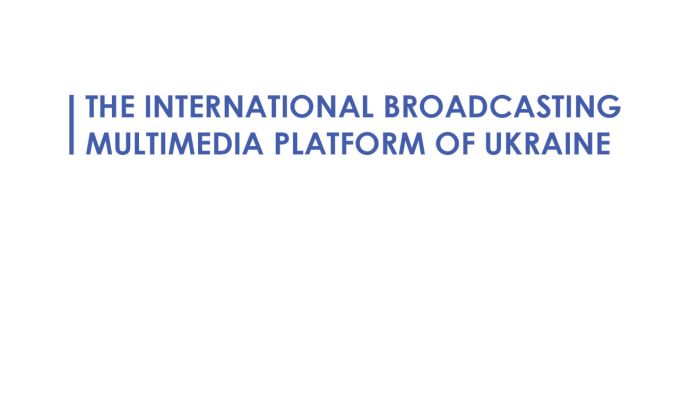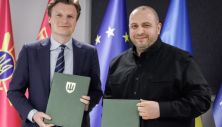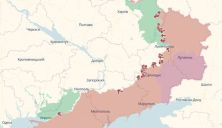The website of the Institute of Mass Information (IMI) has published a study “Internal broadcasting of Ukraine. Who do the State TV Channels “Dim” and “FREEDOM” broadcast to“, author — IMI media expert Oleksandr Ruban, as well as the news about this study “Foreign broadcasting channels work for the domestic audience — IMI analytics“. In our opinion, these materials contain a number of theses and conclusions about the activities of the State Enterprise “The International Broadcasting Multimedia Platform of Ukraine” that do not correspond to reality, and the publications contain incomplete, inaccurate or false information, often presented separately from the context. This misleads the public, in particular, forms a false understanding of the structure, tasks, mechanisms and results of the work of the State Enterprise “IBMPU”, and ultimately may harm the idea of the institution of Ukrainian state broadcasting as one of the instruments of information sovereignty, subjectivity and stability of the country in the global media space.
With this commentary, we aim to convey to the public, international partners and the media the reasoned position of the State Enterprise “IBMPU” regarding the key conclusions and certain theses of the IMI study, which, in our opinion, do not correspond to reality; to refute false information and provide more complete and accurate information about the activities of Ukrainian state international broadcasting, in particular, the TV channels “Dim” and “FREEDOM”; to demonstrate our commitment to the principles of open dialogue with society and the expert community.
To avoid misunderstandings, we would like to emphasize that we fully understand and support the importance of institutions of public control over events and phenomena related to the media space, compliance with the law, use of state budget funds, and other manifestations of civil activism in relation to the public sector. We do not in any way question IMI’s right to conduct monitoring studies of media content, assess its quality and provide consultations, and we support the purpose that guides IMI in its activities and the values it declares, in particular, quality and responsibility.
We are convinced that our commentary will contribute to IMI’s efforts “to form an aware, thoughtful and critically thinking audience”, to quality feedback and to strengthening the standards and principles of work declared in the IMI Editorial Policy, in particular, the dissemination of reliable, accurate, complete information, impartiality and balance of materials, separation of facts from commentary.
In consideration of the arguments set out below, we appeal to the Institute of Mass Information to clarify and/or refute the conclusions, facts, statements, theses and assumptions contained in the study, which, in our opinion, are not true; to publish information about the research methodology; to provide explanations as to the reasons for the absence of IMI or O. Ruban’s request to the State Enterprise “IBMPU” to obtain information that, in the author’s opinion, remains unknown to the public; the logic of the comparisons used in the study; the signs, in our opinion, of various manipulative techniques and methods of devaluation, negative stylistic labeling, fragmentary use of open data and their unjustified scaling and generalization without taking into account the context and ignoring the entire array of available data on the activities of Ukrainian state international broadcasting that contradict the author’s conclusions, or the announcement of them as not essential and false.
1. In the IMI study, we can identify several theses that, in our opinion, do not correspond to objective data, which may lead to false conclusions about the results of the work of the TV channels “Dim” and “FREEDOM”, in particular, that they allegedly contradict Ukrainian legislation and Ukraine’s European integration tasks, are ineffective, and that funding these channels by the state budget of Ukraine is a waste of money. Such theses are systematically present in the text of the study, its title, the author’s introduction, and the IMI news.
Firstly, O. Ruban repeatedly emphasizes that the channels “Dim” and “FREEDOM” work for the domestic audience. This, unfortunately, key message about the work of foreign broadcasting for IMI’s research, is already rhetorically embedded in the title “UKRAINE’S INTERNAL BROADCASTING. WHO Do THE STATE TV CHANNELS “DIM” AND “FREEDOM” BROADCASTING TO”, and the headline of the relevant news item contains it in the format of an imperative ” INTERNATIONAL BROADCASTING CHANNELS WORK FOR THE DOMESTIC AUDIENCE — IMI ANALYSIS”.
This approach seems to be a classic example of manipulation with the help of a headline, when the peremptorily declared “necessary” message sets the modal framework for the perception of the subsequent text. In our case, we can assume that the IMI study is addressed primarily to the media community and institutions that work with the media. Accordingly, the audience of the study, by default, has general information that the key target audiences of international broadcasting are outside Ukraine, as well as about the territories to which the channels of the State Enterprise “IBMPU” can broadcast, according to the law. Thus, the headlines that affirmatively speak of ” internal broadcasting” and ” domestic audience” and that, in fact, attribute to our activities inconsistency with the goals and objectives of international broadcasting, even before reading the text, can form a biased attitude towards the object of the study (in our case, the State Enterprise “IBMPU”). Finally, both the text of the study and its conclusions coincide with the title, as they are also focused on proving the false thesis about the work of the TV channels “Dim” and “FREEDOM” for the domestic audience, while the author, unfortunately, often provides incomplete data or data out of the context necessary for their objective perception.
In the opinion of the State Enterprise “IBMPU”, the thesis about “internal broadcasting” is not true. It contradicts objective facts and data, even those cited by Mr. Ruban. For example, the study contains data on the coverage of the FREEDOM channel (information is available on the broadcaster’s website), including broadcasting via satellite, presence in the national networks of cable operators in 44 countries, as well as on international OTT platforms that are available to viewers around the world. In our opinion, the author’s conclusion about “internal broadcasting” is illogical, given the review and this data, and even more so, they refute it.
We can also add the information that has been repeatedly reported: after the beginning of the full-scale invasion, the State Enterprise “IBMPU” received a high organic demand from providers from different countries for a Ukrainian TV channel in Russian, which would promptly convey truthful information about the situation in Ukraine.
Against the backdrop of Russia’s unprovoked aggressive war against Ukraine, many countries have begun to counter Russian propaganda more systematically, including banning Russian propaganda TV channels. At the same time, the audience of these channels, often affected by Russian propaganda, remains and needs content. Information content in Russian, but with Ukrainian narratives and agenda, is offered to the 280 million Russian-speaking audience of the world by the FREEDOM channel. In 2022, the number of satellites broadcasting through the channel increased from 2 to 6, with four satellites launched in the spring of 2022: Azerspace 2/Intelsat 38 (45.1°E), Hellas Sat 3 (39.0°E), BulgariaSat 1 (1.9°E), Thor 5 (0.8°W) offered to turn us on for free to support Ukraine. In 2023, Ukraine’s foreign broadcasting channel is present in more than 700 national cable, DTH, IPTV networks in 44 countries, 20 of which were added after the full-scale invasion of Russia. In 2023, the state-owned company expanded the presence of the FREEDOM channel in Portugal, the Baltic States, Norway, Denmark, Bulgaria, Georgia, Germany, Poland, Slovakia, and the Czech Republic.
Secondly, the study argues that the situation with state foreign broadcasting “contradicts Ukraine’s European integration commitments”, in particular those set out in the Resolution of the Parliamentary Assembly of the Council of Europe “On the fulfillment of obligations and commitments by Ukraine” on October 5, 2005. Unfortunately, the author speaks about international broadcasting in the general context of state media, ignoring the essential difference of foreign broadcasting, its focus on an external audience, while the PACE Resolution referred primarily to the system of state television and radio companies, which are now represented by the family of brands of the joint-stock agency UA:PBC (the Public Broadcasting Company of Ukraine), on the success of whose reform there is a consensus among European and Ukrainian institutions, and other media for the domestic audience.
We would like to note that the media community, government officials, MPs, representatives of international organizations, and public activists have repeatedly discussed the functioning of foreign broadcasting as a state institution. The results of these discussions are reflected in the Law “On the System of Foreign Broadcasting of Ukraine”, bylaws, statutory documents of the State Enterprise “IBMPU”, numerous news, publications, materials of public events, etc. For the purposes of this commentary, we do not provide them in detail, but only note that the expert dialogue is currently focused mainly on discussions on models of foreign broadcasting development, expansion of language versions (currently, the state-owned enterprise has platforms in Ukrainian, Russian, English, Arabic and Spanish), the feasibility of foreign broadcasting in Russian, opportunities for launching a TV channel in English and other working issues.
Such a dialog demonstrates that the State Enterprise “IBMPU” is a living structure, open to reasonable changes and transformations that strengthen Ukraine’s information stability. At the same time, no one questions the very idea of the institute of foreign broadcasting as a tool for disseminating Ukrainian narratives and establishing the media subjectivity of the Ukrainian state in the global social, cultural and information space; popularizing Ukraine as an organic component of European civilization, getting acquainted with Ukrainian multinational identity and cultural identity; protecting the country’s information sovereignty and systematically destroying anti-Ukrainian myths of Russian propaganda; objective and prompt reporting of information about Ukraine. The arguments for and against the state format of the foreign broadcasting system in Ukraine have been repeatedly mentioned and substantiated, including with reference to the relevant practices of developed democracies. There is now an understanding of why such a format can be acceptable, why international broadcasting does not pose a threat to freedom of speech and democracy in the country and why it needs state support and funding.
Therefore, we will not discuss the issue of the state status of foreign broadcasting in this commentary, but only draw attention to the incomplete chronology provided by the author to support the thesis that the government is strengthening the state media, and clarify this chronology itself. The study states: “According to the 2005 PACE Resolution, Ukraine is obliged to transform state-owned television and radio companies into public broadcasting channels […] In April 2015 […] a package of amendments to the Law on Public Television and Radio Broadcasting of Ukraine was signed. As a result of the reform, the First National TV Channel officially became UΛ:Pershyi […] Until 2019, the authorities controlled only a few media outlets, including the parliamentary channel Rada and foreign broadcasting. In 2020, instead of denationalization, the government began to strengthen the position of foreign broadcasting.”
This chronology does not include information that the law “On the International Broadcasting System of Ukraine” was also adopted in 2015. According to this law, the state-owned enterprise “IBMPU” and the National News Agency “Ukrinform” became part of the foreign broadcasting system. During the years of operation from 2015 to 2020, the then management of the state-owned enterprise came to the conclusion that it was necessary to increase the number of TV channels and create a channel in Russian. For example, at a meeting with schoolchildren in August 2019, the then Director of the State Enterprise “IBMPU” Lyudmyla Berezovska spoke about the plans for the development of the State Enterprise “IBMPU” and explained the need for a 100% Russian-language TV channel as a way to counter Russian propaganda and expressed hope that the Verkhovna Rada of the new convocation (the election campaign for the current parliament was underway) would make the necessary changes to the law and create two TV channels.
In our opinion, the added information is essential for the IMI study, as it shows the general context, internal logic and continuity of the processes of development and strengthening of foreign broadcasting, while the phrase “in 2020… the authorities began…” presented without this information may give the audience a false impression that with the change of political leadership of the country, processes that were not objectively motivated allegedly began in the format of foreign broadcasting.
Thirdly, the study contains messages about the alleged inefficiency of foreign broadcasting, which leads to the author’s assumption that it is inexpedient to finance it from the state budget. Quote: “The Russian-language “FreeDom” is unlikely to have a serious impact on Russian public opinion, but it is represented on all possible platforms inside Ukraine. The channel “Dim” produces mostly Ukrainian-language entertainment content. Therefore, these state-owned and, accordingly, loyal to the government TV channels, if they have an impact on the audience, then it is the domestic Ukrainian audience. This situation raises doubts as to whether taxpayers’ money should be spent on them”.
First of all, we would like to note that, in our opinion, incorrect comparisons and analogies, incomplete and irrelevant data were used to substantiate these messages. For example, the author cites statistics from the BIG DATA UA report on viewing via IPTV and OTT services in Ukraine. Based on it, O. Ruban makes assumptions about viewing on cable operators’ networks and via satellite and notes that “the channel (“Dim” — ed.) is definitely not a giant of the Ukrainian TV market”. The author ignores the fact that foreign broadcasting is not focused on the domestic TV market. We, in turn, believe that the comparison of “Dim” and “FREEDOM” TV channels with national TV channels is incorrect. In Ukraine, there is no FREEDOM channel on cable networks, while “Dim” TV channel is available only where it is permitted by law, currently in certain areas of Donetsk region. Broadcasting via IPTV and OTT services is not prohibited by law, but some OTT platforms block the viewing of the FREEDOM channel in Ukraine.
The author also refers to the data on YouTube views (both open and published by the State Enterprise “IBMPU”) selectively, focusing on what confirms the general conclusions of the study. For example, the data on 72% of views of the content of the Dim channel from Ukraine is sufficient for the IMI expert to claim that it has an impact on the domestic audience, while the data on more than 60% of views of the FREEDOM and FREEDOM.LIVE YouTube channels from Russia is not enough to say that the channel is popular with the Russian audience. At the same time, the IMI study does not indicate that 90% of views of FREEDOM and FREEDOM.LIVE YouTube channels come from abroad: in addition to Russia, these are Kazakhstan, Uzbekistan, Belarus, the Baltic States, Germany, etc. For example, in October-November, Israel entered the top countries in terms of views for the first time. Also absent from the IMI study is the weighted average of foreign viewership of content under the FREEDOM brand on the YouTube channels of the state-owned enterprise “IBMPU” and partner media groups — 78%, or data on the list of cities with the highest percentage of FREEDOM viewers, which practically does not include Ukrainian cities. For example, in November, there were only 3 Ukrainian cities on this list: Kyiv on the 12th place, Dnipro on the 40th, and Odesa on the 41st. The top 10 cities are the following: Moscow, Krasnodar, St. Petersburg, Rostov-on-Don, Yekaterinburg, Nizhny Novgorod, Irkutsk, Novosibirsk, Samara, and Chelyabinsk. These statistics, if they had been used in the study, in our opinion, refute several false theses of the IMI expert, which can devalue the results of foreign broadcasting. Here are some of the following theses: “Ukrainian media show Russian-language content of FreeDom to their audience, i.e. domestic Ukrainians”; “although the heads of the State Enterprise IBMPU and the TV channel claim that the majority of Freedom content consumers are Russians, there is no sufficiently thorough research to prove such statements”; “…the TV channel “feeds” the Ukrainian audience with the agenda of the aggressor country, presented in its own language”.
In our opinion, the author’s use of Russian sociological data on the growth of hostile attitudes towards Ukrainians over the past two years as an argument to support the thesis that the FREEDOM channel is “ineffective” is also manipulative. “Even if we assume that the TV channel has a wide audience in Russia, its impact on the situation in that country, on the consciousness and civic position of its citizens will remain questionable. It’s easy to see that the truth has no effect on aggressive Russians,” — the study says. We agree that it is difficult to influence an audience that is constantly under the influence of powerful Russian propaganda, but the complexity of the task does not mean that it should not be done. Especially since there is a demand for information about Russia’s war against Ukraine among the Russian-speaking audience, and it is not only residents of the Russian Federation. In our opinion, this demand should be satisfied, among other things, by a Ukrainian TV channel in Russian, which delivers truthful information from a Ukraine-centered perspective, otherwise our country will be in a situation where they will talk about us without us.
We are convinced that the author of the IMI study understands no worse than we do that Russian propaganda has been working for centuries to completely deny Ukraine as a state and will continue to do so in the future with the resources it has. We are fully aware that foreign broadcasting is only one of the tools of Ukraine’s media subjectivity. Nevertheless, at a time when Russia is constantly transforming and intensifying its anti-Ukrainian propaganda in the world, we believe it is unproductive to devalue the institution of Ukrainian broadcasting and express doubts about the feasibility of its funding. We hope that our commentary will provide IMI with the necessary clarifications and eliminate this misunderstanding.
Another common thesis in the IMI study is the author’s assumption that “Ukrainian foreign language TV channels […] can be used to influence the domestic audience, for example, in favor of the authorities during elections.” This assumption is not true. We have repeatedly reported that foreign broadcasting is not focused on the domestic audience. We do not indicate the political affiliation of certain politicians on the air of “Dim” and “FREEDOM” TV channels, as for our viewers they are all representatives of the state of Ukraine, not different political forces within the state.
2. We also ask IMI to publish information about the methodology used by the author of the study, its subject, tools, and methods of analysis. IMI’s materials state that all studies have a solid methodological basis and all methodologies are published on the organization’s website. Unfortunately, we did not find a reference to the methodology in the text of the study, so we ask that it be added. Perhaps such a clarification will allow us to better understand how the author came to the conclusions about “internal broadcasting” and its ineffectiveness.
3. One of the methods used in the IMI study to analyze the effectiveness of the Dim and FREEDOM TV channels is comparison, in particular with private Ukrainian TV channels and TV channels from the Public Broadcaster family. In our opinion, such comparisons are not entirely correct, as they ignore the essential characteristic of foreign broadcasting, its work for an external audience. At the same time, despite all the differences in tasks, audiences, broadcasting territory, etc., foreign broadcasting and the Public Broadcaster have a common technical characteristic — funding from the state budget of Ukraine. Probably, from this point of view, the state-owned enterprise “IBMPU” and UA:PBC JSC can be compared.
Therefore, in the following comments, we will also use a comparison of the sites of the State Enterprise “IBMPU” with the corresponding sites of the Public Broadcaster. However, we will make a clarification that is important for understanding the financial resources that these two organizations can dispose of: The state-owned enterprise “IBMPU” is financed from the state budget and practically does not attract financial assistance from external donors, since assistance through the grant system is primarily provided to projects implemented within the country, and in the media sector, not belonging to the public sector. JSC UA:PBC, in addition to budget funding, widely attracts donor assistance. We do not have information about the amount of grant assistance to UA:PBC in the current year, but according to the Report of JSC UA:PBC in 2022, it amounted to about $12.9 million. (budgets are indicated for the entire period of project implementation based on signed agreements). This amount is actually equal to the annual funding of the State Enterprise “IBMPU” (excluding funds allocated to finance the information marathon and to finance the winning projects of the artistic competition for the production of series and films on contemporary topics).
4. The author of the study repeatedly emphasizes that the State Enterprise “IBMPU” allegedly does not publish data on the views of the “Dim” and “FREEDOM” channels on any platforms other than YouTube, which is why there is not enough information to analyze their popularity, as well as their broadcasting in the country or abroad. In the context of the study, such statements may be perceived as confirming the opacity of the State Enterprise “IBMPU”, which is not true.
At the same time, it seems illogical to us that, feeling that the data is “incomplete,” neither IM,I nor O. Ruban made any request to the SE “IBMPU” to obtain such data or an explanation for its absence. Therefore, we provide this information on our own initiative.
The State Enterprise “IBMPU” does not measure the viewership of TV channels “Dim” and “FREEDOM” either domestically or externally in digital, analog, cable networks and on satellite for several reasons. The company does not focus on the domestic audience, so there are practically no domestic broadcasts of the channels, except for those allowed by law, but they are insignificant. Accordingly, there are no TV channels of the State Enterprise “IBMPU” in the ppm panel. As for the study of viewing figures abroad, these are expensive studies, the financing of which is not provided for in the current budget of the State Enterprise “IBMPU”.
That’s why we focus on digital metrics, as the tools for analyzing them are either free or relatively inexpensive and can provide insight into our viewership across many parameters. Here we use analytical tools from the digital platforms themselves, as well as reputable independent tools, including Google Analytic, YouTube Studio, Meta Business Suite, Sab.Box (Genesis) analytics, etc.
If the expert community has any doubts about the objectivity and reliability of the conclusions we draw based on digital viewership data, we are always ready to provide the source data or any necessary comments on it. In our opinion, this will help to avoid fragmentation and one-sidedness in the coverage of the work of the State Enterprise “IBMPU” and will strengthen the credibility of our institution.
At the same time, we understand the need for a more complete study of the presence of Ukrainian state broadcasting channels in the global media space, so we plan to reach agreements with donor organizations to finance relevant research.
5. It should be noted that the study does not contain complete information about media brands that are part of the state-owned IBMPU. Today, there are six of them: the Ukrainian-language TV channel “Dim”, the Russian-language TV channel FREEDOM, YouTube channels in English, Arabic and Spanish: UATV English, UATV Arabic, UATV Español and the English-language digital platform The Gaze.
We understand that the IMI study focused on the broadcast channels, but without a general mention of the other brands, the audience may have a misunderstanding of the priorities and structure of foreign broadcasting, as well as the amount of its funding. Therefore, we consider the omitted information to be essential and ask that it be added to make the study more complete and correct.
6. Unfortunately, the study lacks some factual information, contains a number of inaccuracies and false statements about the program concept, content, viewings and other aspects of the work of the SE “IBMPU”. We do not deny that some of the information was indeed not previously published by us. Since neither IMI nor the author addressed the state-owned enterprise “IBMPU” with relevant requests prior to the publication of the study, we provide below the clarifications, additions and explanations that we believe will contribute to a clearer understanding of the activities of the foreign language broadcasting.
The study states: “The Dom TV channel was launched in 2020. It was supposed to broadcast to the temporarily occupied territories of Ukraine. In March 2023, the National Council decided to reissue the license of the TV channel “Dom”. After that, the channel changed its logo to “Dim” and revised its broadcasting concept. Now it is a channel dominated by entertainment content.” Please note that since the beginning of the full-scale invasion, Dim TV channel has been broadcasting the United News marathon, and on September 12, 2022, it began broadcasting in an updated format. Since then, the channel has been broadcasting content aimed at supporting Ukrainian refugees abroad and internally displaced persons, and we would not call it entertainment, unless the author means any non-news content by “entertainment.” The channel did change its logo in March 2023, which was due to the length of legal procedures.
The study provides analytics on the YouTube channel “Dim” from the presentation of the State Enterprise “IBMPU” in October, according to which 72.5% of the audience is from Ukraine, Poland — 4.2%, Russia — 3.9%, Germany — 3.6% and Italy — 2%. Yes, today the majority of digital views are indeed from Ukraine, but the share of views from abroad has increased from 10% to almost 30% over the year.
We would like to clarify the information on the plans for international distribution of the TV channel “Dim” in 2024, which was provided by Julia Ostrovska, Director of the State Enterprise “IBMPU”, at a meeting of the relevant committee of the Verkhovna Rada. Since the initial concept of the TV channel envisaged broadcasting to certain territories of Ukraine, some of the content purchased in 2020-2021 had restrictions on broadcasting abroad. In 2022-2023, this slowed down the development of the international distribution network to a certain extent (however, the launch and development of the channel’s digital platforms showed that there was a demand for it among audiences from different countries). In 2024, these restrictions will expire, and the state-owned enterprise plans to actively develop the international network of the DIM channel, primarily in countries with a significant community of Ukrainian refugees and a corresponding demand for our channel.
The author of the study goes on to provide the number of subscribers and statistics of views on the digital platforms of “Dim”. In passing, Ruban notes that some videos receive millions of views, but the author concludes a brief description of almost every project of the TV channel with a summary of “only a few tens of thousands or a few thousand views,” which is obviously meant to demonstrate the low popularity of the TV channel. Indeed, we have videos with different numbers of views, as all broadcasters do. Nevertheless, in order to have metrics for comparison, here are a few examples from the YouTube channels of the Public Broadcaster with which O. Ruban compared us. YouTube channel “Dim” (actually developed since September 2022) has 161 thousand subscribers, 77.5 million views. YouTube channel “Suspilne. Culture” (founded on May 31, 2018) — 95 thousand subscribers, 17.3 million views. YouTube channel “Suspilne. Crimea” (founded on March 18, 2014) — 4.3 thousand subscribers, 1.3 million views. Or consider an example with another product. The YouTube channel ‘Suspilne. Culture’ aired the premiere of ‘Carlos in Ukraine’ (12 episodes of 30 minutes each, winner of the art competition by Torzhevskyi N.) on December, supported by the European Union and Transtele — Canal France International’s full donor support. The first episode received almost 70,000 views, while the other episodes have been watched by several thousand viewers each. The series worth 4620 thousand hryvnia has received about 115 thousand views, which isn’t too high, but there’s no doubt about the importance of such content.Therefore, we believe that the IMI expert’s conclusions about the low popularity of “Dim” are at least premature.
The IMI expert’s description of the project “Quiet Evening with Olena Kravets”, firstly, contains devaluing phrases, such as “this is another attempt by Ukrainian television to recreate the late night show format” or “the show is not much different from other similar entertainment content”. We would like to point out that there are not too many genres of television product in general, and its uniqueness depends primarily on how the creative team of any project can rethink a well-known format. Secondly, O. Ruban’s description demonstrates only a cursory acquaintance of the IMI expert with the object under study. It reads: “The guests of the program are mostly bloggers, musicians and military personnel. At the same time, it was expected that top politicians, civil servants and representatives of critical infrastructure would also be invited.” Thus, we would like to inform you that the guests of the project were: Minister of Foreign Affairs of Ukraine Dmytro Kuleba, Nobel Peace Prize laureate Oleksandra Matviichuk, Minister of Education Oksen Lisovyi, YASNO director Serhiy Kovalenko, then-Minister of Defense of Ukraine Oleksiy Reznikov, Head of Mykolaiv Regional Military Administration Vitaliy Kim and other top politicians and officials.
- The information about other projects of the DIM TV channel is presented in a similar format, and it is noteworthy that most often the project titles have hyperlinks to episodes with a small number of views. For example, the project “I Will Not Forget” has a link to an episode with 4.6 thousand views, while next to it is an episode of the same project with more than 500 thousand views. Although it is not easy to evaluate projects such as “I Will Wait” or “I Will Not Forget”, which tell very sensitive stories, in terms of the number of views, we should note that they resonate with the audience, and the selections of key moments get high views on various platforms of the TV channel “Dim” on social networks. We should also note the author’s tone in the description of” I Will Not Forget”: “Another project in the format of an interview in the studio […] non-public Ukrainians tell their war-related stories […] The program is watched by several thousand people,” the study says. In our opinion, the term “just another” is simply inappropriate for the extremely difficult, yet life-affirming stories that the Dim channel documents in the “I Will Not Forget” project.
The author draws attention to the topics of the “Morning at Home” stories and the indicators that the project collects on its YouTube channel: “The show consists of interviews with guests and stories on various topics: Ukrainian history, literature, cooking, and others. Most of the time, the videos get a few dozen or hundreds of views, sometimes several thousand.” We would like to add that the key topics for the “Morning at Home” are stories of Ukrainians abroad, psychological support, coverage of charitable and volunteer initiatives, and stories about the adaptation of internally displaced persons to life in new communities. We draw attention to this, as this information is important in the context of the overall mission of the channel and understanding the social rather than entertainment orientation of its content. As for the viewing figures, of course, we are working to make them higher. However, let’s again take the YouTube manifestations of the “First Show” project of the Public Broadcaster, with which we are often compared, for comparison. The “First Show” does not have its own channel, but we managed to find some stories on the YouTube channel “Suspilne. Country” (3,000 subscribers, 460,000 views), where “Morning on Suspilne” stories were previously published, and on the personal pages of the hosts: most of the videos of the “First Show” do not even have a few hundred views. The YouTube channel “Morning at Home” has 16 thousand subscribers, 8.8 million views.
Summarizing his research on the Dim channel, the author of the study concludes: “‘Dim’ produces entertainment, cultural, educational and social content that hardly fulfills the task of promoting the Ukrainian information agenda. From a practical point of view, this channel has nothing to do with foreign broadcasting. According to the platform’s management, the TV channel is focused on internally displaced persons and people who have moved abroad. However, Dim’s content is mostly non-specific and seems to be aimed at a national audience.” Firstly, the tasks of foreign broadcasting are to promote not only the information agenda, which is detailed in the Law of Ukraine, the Statute of the State Enterprise “IBMPU” and our numerous publications. Secondly, “Dim” has enough content dedicated specifically to refugees and IDPs: these are separate program lines, such as “I Will Wait”, and special thematic sections that are broadcast daily on “Morning at Home”. Thirdly, we have repeatedly explained that the “DIM” channel is not a channel exclusively about IDPs and refugees. We constantly keep their issues in focus, and the channel sees its task as making them feel the country’s attention and need for them, in our case, through audiovisual content. On the other hand, it is important that Ukrainians abroad do not lose touch with home and do not become encapsulated in the migrant present. Therefore, it is logical that Dim has content that is interesting to a wide audience.
As for the FREEDOM channel, it is not available on Ukrainian cable networks, and viewing the channel from the territory of Ukraine is blocked on some OTT platforms.
The author notes that “it is currently impossible to determine whether the channel is watched more in Ukraine or abroad”. We disagree with this statement. Firstly, the above data on YouTube views indicate that the main consumer of the channel is abroad. Secondly, the presence on more than 700 national cable, DTH and IPTV networks in 44 countries, as well as on ten international OTT platforms that are available to viewers around the world, which is available on the channel’s website, also indicates that the channel is watched outside of Ukraine.
Regarding the number of views of content under the FREEDOM brand on various digital platforms, the author’s “exposing” style of total views and the devaluing characterization — “only 1.9 billion” — regarding the indicators on the SE IBMPU own platforms are unclear: “Meanwhile, the State Enterprise “IBMPU” reports 8.9 billion views (as of November, it is already 9.6 billion — SE “IBMPU”) of FreeDom content on digital platforms. It turns out that this figure is the sum of the data of partners — 1+1 media, Starlight Media and Inter Media Group, which also distribute Freedom products on their social media pages. That is, 7 billion views for the content of the state-owned foreign broadcasting channel were collected by the platforms of Ukrainian private media groups, and only 1.9 billion views on social media are Freedom’s own achievement,” the IMI expert writes. Please note that in each of our communications regarding digital viewing figures, the State Enterprise “IBMPU” always indicates where it refers to the total figures of all platforms, where it refers to their weighted average figures, and where it refers to our platforms. Regarding the estimate of 1.9 billion — whether it is a lot or a little, of course, we always strive for more, but with the same YouTube channel of the Public Broadcaster (we take YouTube because the data here is open to everyone): “Suspilne. News”: 586 thousand subscribers, 285 million views; “FREEDOM”: 990 thousand subscribers, 686 million views; “FREEDOM. LIVE”: 712 thousand subscribers, 346 million views.
The author of the study is also wrong that since the content of the “FREEDOM” channel is broadcast on their platforms by Ukrainian media groups, which, together with the state-owned “IBMPU”, are the producers of this content, they broadcast it for a domestic audience. Above, we have given the weighted average of foreign audience for these YouTube channels, which is currently 78%. We also publish monthly information on the digital viewing of “FREEDOM”, which includes the percentage of views from Russia and abroad for each platform separately. Moreover, the State Enterprise “IBMPU” has repeatedly stated that it is ready to provide FREEDOM content to YouTube channels for free for distribution to target audiences if these channels meet the requirements, the main of which is the predominance of non-Ukrainian viewers in the audience structure. By the way, the predominance of the audience from Ukraine was the reason why the state-owned IBMPU did not provide FREEDOM content to the Channel 24.
The author of the study goes on to describe the content of the “FREEDOM” channel in the same style as the Dim channel: a few sentences ending with a phrase about low views. Unfortunately, the researcher does not mention videos with hundreds of thousands or millions of views. Therefore, it should be noted that the content requested by the foreign audience is information about the course of events at the front, information about Russian mobilized and prisoners of war, news about human rights violations in Russia, addresses and statements of the President of Ukraine, and these videos usually have the highest percentage of views from outside Ukraine, sometimes reaching 98-99%.
Even if some content, such as “Let’s check it out,” seems to the author to be “in demand among Russians,” Ruban immediately repeats his, in our opinion, artificially constructed message that FREEDOM is broadcasting to a domestic audience.
We also see nothing surprising in the fact that “almost all of Freedom’s reports are from the front line and the frontline territories.” After all, today the channel’s main task is to convey to the Russian-speaking audience abroad the truth about Russia’s war against Ukraine and to refute the fakes of Russian propaganda. Without live reports from the frontline, it would be difficult to achieve this.
The accusation that the Front News program is “created by Ukrainians and talks about the war in Ukraine, which is reflected in the emotional presentation of the stories” is unclear. This raises doubts that such a product will find a viewer among Russians,” the study says. In our opinion, this statement contradicts the previous statement of the author himself, who a few paragraphs earlier expressed concern that “FREEDOM” shows Russian politicians, and then in the conclusion also reproached the channel for “feeding” its Ukrainian audience with the agenda of the aggressor country.” In our opinion, the fact that the vast majority of content on the state-owned IBMPU and the “FREEDOM” channel is created by Ukrainians is a natural thing for a Ukrainian channel, even though it is a Russian-language one. And we are indeed working on the tone of the stories addressed to different audiences, and judging by the viewing figures, we are succeeding.
We would also like to note that, unfortunately, we did not find any information in the IMI study about the information campaigns of the “FREEDOM” channel, such as support for the project “I Want to Live”, which calls on the Russian military to surrender, or the initiative “If You Know, Tell”, which aims to help the state in the search for Ukrainian children illegally deported by Russia. Instead, the entire text is marked by devaluing stylistically marked words, phrases, syntactic constructions, stereotyped clichés without substance, such as “state, respectively, loyal to the authorities,” which are supposed to emphasize key messages about the alleged ineffectiveness of foreign language broadcasting (there were plenty of them in the above quotes). We hope that such examples are not a sign of bias in the study, but only a feature of the author’s style. At the same time, we would like to draw attention to the fact that they can form a biased attitude towards the SE “IBMPU” and a misunderstanding of its work.
Dear colleagues, we hope that the misunderstanding of the objectives and results of the work of the SE “IBMPU” in the study of the IMI is an unfortunate mistake that resulted from the lack of information of its author. Taking into account the public importance of the issues raised in the IMI study and the comments of the SE “IBMPU”, we appeal to the IMI to publish our comment in full, without changes, on the Ukrainian and English versions of the website https://imi.org.ua/.
We understand that the State Enterprise “IBMPU” is the subject of the IMI study, which draws critical conclusions about our activity, and our analysis and assessment of this study cannot be excluded, so we also appeal to the Commission on Journalistic Ethics to review the above-mentioned IMI publications on compliance with journalistic standards.
In order to promote constructive interaction between government and civil society institutions and to continue an open dialogue on ways to develop Ukrainian foreign broadcasting, we are also sending this commentary to representatives of international institutions and donor organizations working in the field of information policy, countering Russian propaganda, protecting the rights and freedoms of journalists, protecting freedom of speech, compliance with journalistic standards and other relevant issues of media functioning.
Press service of the SE “IBMPU”













